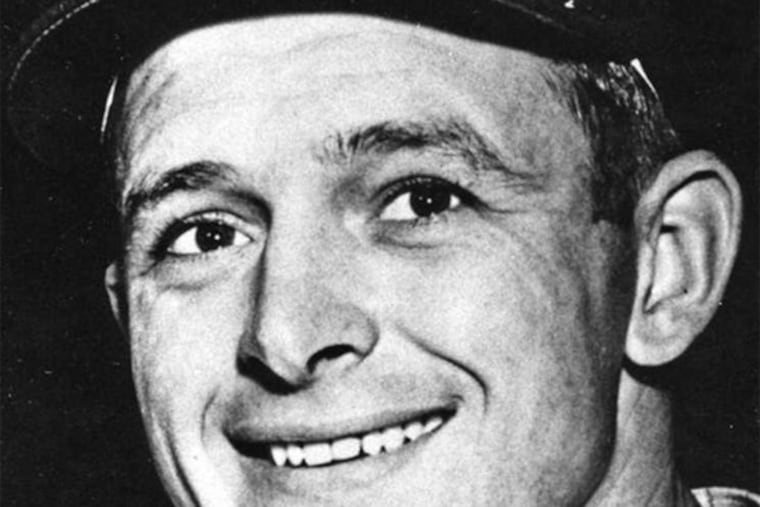Stan Lopata's crouching stance set him apart
Stan "Stash" Lopata, 87, the popular Phillies catcher whose distinctive batting crouch was imitated by young Philadelphians in the 1950s, died Saturday of heart disease at the Hospital of the University of Pennsylvania.

Stan "Stash" Lopata, 87, the popular Phillies catcher whose distinctive batting crouch was imitated by young Philadelphians in the 1950s, died Saturday of heart disease at the Hospital of the University of Pennsylvania.
A two-time all-star (1955, 1956), Mr. Lopata still holds the Phillies' season records for catchers in triples (seven) and home runs (32). He hit 116 home runs in 822 games with the Phillies between 1949 and 1958. His most productive season came in 1956, when he batted .267 with 32 homers, 33 doubles, and 95 RBIs.
With Mr. Lopata's passing, only four members of the Whiz Kids, the pennant-winning 1950 Phillies, remain: Curt Simmons, Putsy Caballero, Jack Mayo, and Bob Miller.
"Stan was one of my dearest friends," Miller said. "We were together as teenagers in American Legion ball and together 10 years later with the Phillies."
A Detroit native, Mr. Lopata entered the Army after his high school graduation in 1943, and received a bronze star and purple heart while serving in France.
The Phillies, beginning at last to spend some money under young owner Bob Carpenter, signed the muscular catcher in 1946 with a $20,000 bonus. A year later, he was the Eastern league's MVP after hitting .325 at Utica.
The young catcher joined the Phillies late in the 1949 season and served as Andy Seminick's backup in 1950, when the club captured its first pennant in 35 years. Little used that year, he hit .209 with one home run. He struck out in his only at-bat of that World Series, which the New York Yankees swept.
Mr. Lopata and Seminick split playing time more evenly in 1951, before the latter was traded to Cincinnati. Mr. Lopata then platooned with Smokey Burgess and others until his hitting improved to the point at which, in 1956, he often played first base against lefthanded pitchers.
A powerful man, Mr. Lopata began his most productive period in 1954, when he adopted a radical new batting stance. Deeply crouched, with his hands tucked under his chin, he began launching balls into Connie Mack Stadium's left-field grandstands and beyond. In spring training, he once hit a ball measured at 510 feet.
The stance proved a godsend for his career. Using it, he had 10 hits in his first 22 at-bats and, over the next four seasons, averaged 24 home runs.
The stance was so unusual that Dizzy Dean, then a baseball broadcaster, said Mr. Lopata looked "like a man hitting from an easy chair." Some opposing players and managers, concerned about his shrunken strike zone, complained that it was illegal.
When he also began wearing tinted sunglasses behind the plate - the glare from stadium lights affected his eyes - Mr. Lopata became something of a cult figure here, with countless young Philadelphians in that drab era emulating his flashy style.
He enhanced that status during a game in 1954, when, because of the searing heat, he and Cardinals catcher Bill Sarni caught without chest protectors.
So popular did he become for a time that after the Phils finished 1956 with a disappointing 73-81 record, a club official said everyone on the team, except for Mr. Lopata, would be on the trading block.
Two years later, after the 1958 season, the Phils dealt Mr. Lopata to the Milwaukee Braves in a deal that brought the Phillies Gene Conley and Joe Koppe. Used sparingly with the Braves, he was released in 1960.
Mr. Lopata later worked at a Michigan steel mill before returning to Philadelphia, where he worked in sales for both IBM and a concrete company. After his retirement from the latter job, the Lopatas moved to Arizona but returned again to the Philadelphia area a year ago.
His funeral was Wednesday.
He is survived by his wife of 65 years, Betty; sons Anthony, Gregory, and Matthew; and daughters Joann, Mary Terese, and Carol. Another son, Thomas, preceded him in death. He had 16 grandchildren and eight great-grandchildren.